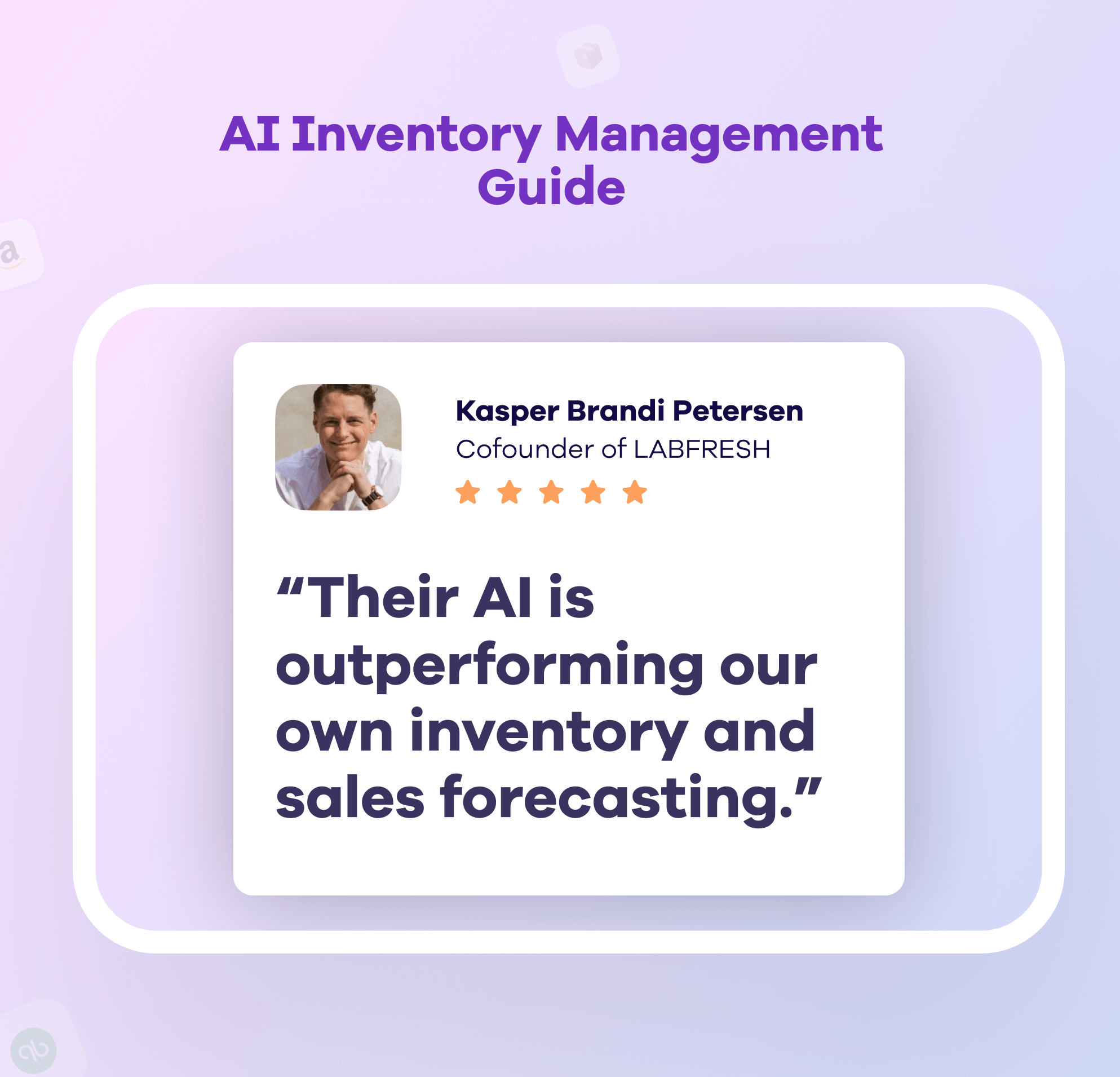Your forecast looked solid. The team stocked up, launched a campaign, and traffic started climbing. But when orders should’ve rolled in, they didn’t. Sales stayed flat. Inventory was off. Some SKUs flew off the shelves, while others gathered dust.
That’s what happens when your demand planning doesn’t keep up. AI-powered demand forecasting and planning software help avoid costly mistakes. They track SKU movement, factor in real-time sales and seasonality, and generate forecasts you can actually act on.
We’ve reviewed top platforms that do just that. Let’s dive in.
Features to look for in an AI-Powered Demand Planning & Forecasting Software
Before you invest in an AI-powered forecasting tool, make sure it can actually solve your inventory challenges. The features below address the most common ones.
1. Real-time data sync
Forecasts are only as good as the data behind them. Make sure your chosen software integrates with your eCommerce platform (like Shopify) to pull the latest numbers from all your sales channels, POS systems, and inventory records.
This way, if a SKU starts selling faster than expected or a large order lands, your forecasts and reorder quantities update instantly, helping you reorder on time and avoid costly stockouts or overstocks.
2. SKU-level forecasting
Look for a tool that doesn’t just forecast at the product or category level, but drills down to the SKU level. This allows you to account for variations across color, size, or channel.
SKU-level forecasting helps teams spot demand shifts in specific product variants early, rather than realizing too late that only one size or color was bringing in most of the sales.
For example, if one variant of a sneaker is selling out repeatedly while others remain untouched, a good AI tool flags the bestseller for replenishment and the slow movers for clearance.
3. Automated reorder recommendations
The best AI-powered tools for demand forecasting in supply chain management tell you exactly what to order, when, and how much, based on demand forecasts, lead times, and safety stock. This removes guesswork and prevents last-minute scrambling.
For example, if a product is projected to sell out in 10 days and the supplier lead time is 7, the system should prompt a reorder now. Without this feature, teams risk stockouts or rush orders that increase costs.
4. Location-specific forecasting
Demand isn’t the same everywhere; what sells out in one store or region might move slowly in another. Location-specific forecasting breaks down sales data by store, warehouse, or region, so you can see exactly where demand is strongest.
If you’re a scaling business, this is an important feature for you.
By stocking each location based on its unique sales patterns, you avoid understocking high-demand areas and overstocking where products don’t move as quickly, keeping inventory balanced and costs in check.
5. Easy integration with existing systems
Forecasts are accurate only when they are well-connected to your ecosystem. Seamless integration with your existing software, like eCommerce platform, ERP, WMS, accounting software, and 3PLs, ensures all data flows into one place.
This eliminates manual data entry, reduces errors, and gives your forecasts a complete picture of demand drivers. The more connected your systems are, the more accurate and actionable your inventory decisions become.
Comparison of Best 9 AI-Powered Demand Forecasting Software
9 Best AI-Powered Demand Planning & Forecasting Software
After extensive research and comparison, we’ve narrowed it down to the top 9 AI-powered demand forecasting tools worth your attention.
1. Prediko
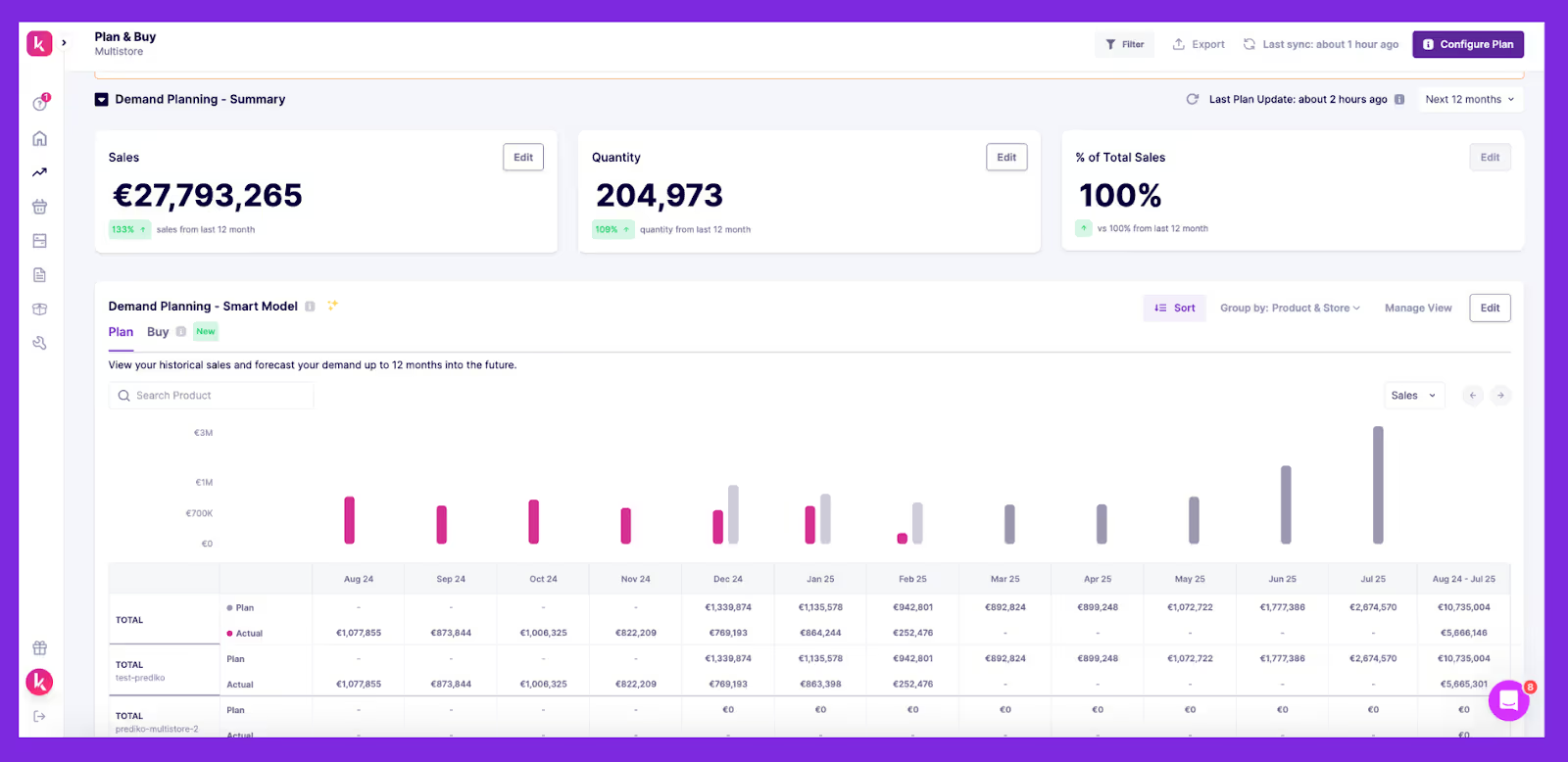
Prediko is #1 AI-powered demand planning & forecasting software for Shopify brands. Its forecasting AI is trained on over 25M+ SKUs across 15 industries and factors in seasonality, past sales, and growth trends.
You feed in your own inputs to fine-tune the AI-generated plans. It pulls real-time data from your store, including products, inventory, supplier info, and sales performance, and builds forecasts based on how SKUs are actually moving.
When a product is running low, Prediko flags it, tells you exactly how much to reorder, and lets you create a purchase order with one click. You can also customize reorder rules like lead time and safety stock for each SKU.
Once supplier details are synced, you’ll never need to manually update lead times or MOQs across multiple orders. Prediko keeps everything aligned so you can spend less time on manual tasks and more time acting on what matters.
Key features
- Multi-store real‑time data sync across Shopify stores, warehouses, and locations
- AI demand planning on SKU-level factoring in sales trends, seasonality, and growth patterns
- AI supply plan that recommends what to buy, when, and in what quantities
- Create, track, and send purchase orders directly to your suppliers
- Low‑stock and at-risk alerts that let you know of stockouts before they happen
- Raw materials tracking and forecasting with BOM (Bill of Materials) management, linking forecasted demand with production needs
- 10+ customizable inventory reports and analytics, delivering daily and weekly insights on PO activity and stock risks straight to your inbox
- 70+ integrations with WMS, 3PLs, and leading eCommerce platforms
Pros
- Highly praised for AI-driven forecasts and demand planning accuracy
- Supports unlimited users at no extra cost, so your purchasing, planning, and operations teams can work together in one platform
- Handles end-to-end stock planning, including raw materials and finished goods
- Excellent support team and quick onboarding
Limitations
- Amazon integration (Releasing soon)
- Advanced forecasting might not be suitable for small brands
Kimai saves 20 hours/week with Prediko
Kimaï, a luxury sustainable jewellery brand loved by Meghan Markle and Emma Watson, crafts lab-grown diamond pieces with recycled gold. As their made-to-order business grew, they struggled with predicting demand, managing multiple suppliers, and long delivery times.
After switching to Prediko, they cut delivery times by 43%, reduced production costs by 11%, and saved 10+ hours a week on inventory management.
Ratings
Prediko is rated 5 star rated on the Shopify App Store based on 100+ merchant reviews praising its features and responsive support team.
Pricing
Prediko offers tiered pricing based on your store’s revenue. Plans start at just $49/month for small businesses and scale up to $119, $199, and $349/month for more advanced needs. All plans include unlimited SKUs, purchase orders, and users.
2. Monocle AI
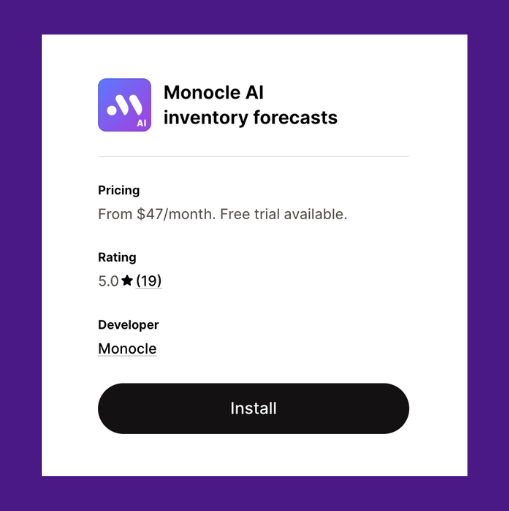
Monocle is an AI-powered demand planning tool designed to help eCommerce businesses replace guesswork with clear, data-driven decision-making.
Using AI algorithms, it analyzes historical sales data, detects trends, and predicts future demand across your product catalog.
This allows merchants to proactively prevent stockouts, reduce excess inventory, and improve cash flow by ordering only what’s needed, when it’s needed.
Key Features
- AI-powered demand forecasting for accurate stock planning
- Predicts future demand across all SKUs to prevent stockouts
- Optimizes working capital by recommending exactly what to order and when
- Automated detection of sales patterns, reducing manual analysis time
- Order quantity recommendations to minimize excess inventory costs
- Confidence scores for all predictions to guide decision-making
Pricing
Plans start at $47/month
3. Datup AI Powered Demand Planning Software for Supply Chain
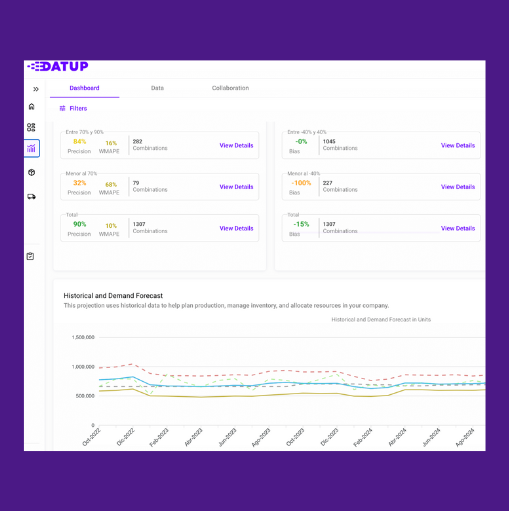
Datup is a supply chain analytics platform with a really strong AI-powered demand planning software. If your company brings in over 10M USD and you're running industrial operations in retail, manufacturing, pharma, or distribution, this could be your best bet.
Datup helps supply chain teams forecast demand and optimize inventory using AI and Deep Learning. It connects with your historical data, ERP, WMS, TMS, and pretty much any data source you've got to create predictive demand forecasts that average over 95% accuracy.
The platform integrates securely and keeps your data protected. One of the big wins here is how fast you can get it up and running—8 weeks max and you're making demand planning decisions with your own data. There's also a supply chain-trained assistant that helps you analyze data, plan, and troubleshoot issues.
Key features:
- Demand forecasting by SKU, location, and product category with up to 95% accuracy.
- Smart portfolio classification with ABC, FSN, and XYZ analysis across your forecasted inventory.
- Intelligent inventory replenishment that factors in your demand forecast, business rules, and custom lead times.
- Collaboration dashboard for cross-functional teams, enabling Supply Chain Collaboration and Sales and Operations planning from one centralized source.
- AlaIA: An AI assistant trained specifically for supply chain: basically an extra team member with built-in expertise to help you get more from your data.
Pricing
Datup works on a monthly subscription that varies based on your operation size and which modules you need. There's no free trial, but they'll give you a live demo with their sales team. No user limits and no implementation fees.
4. Sumtracker
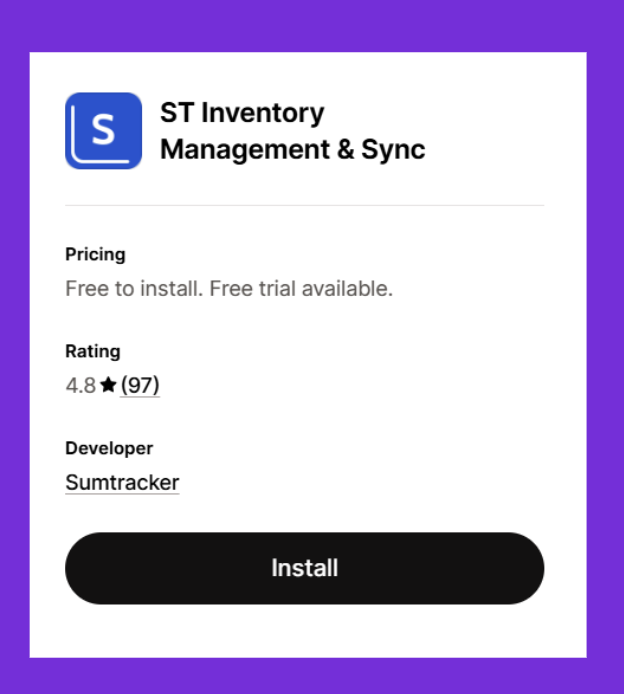
Sumtracker is a powerful demand planning and inventory forecasting tool designed for Shopify brands selling across multiple channels. It syncs inventory in real time across Shopify, Amazon, Etsy, eBay and Walmart, giving you complete visibility of stock levels. With accurate forecasting based on sales velocity and lead times, it helps you anticipate future demand instead of reacting after stock runs out.
It also simplifies reordering with smart purchase suggestions that tell you what to restock, when to order, and how much to buy. You can automate purchase workflows, prevent overstocking or stockouts, and avoid spreadsheet-heavy planning.
Key Features
- Inventory forecasting with automated PO recommendations
- Automated reorder suggestions using sales velocity & lead times
- Reorder timing and quantities calculated automatically
- Real-time inventory sync across Shopify, Amazon, Etsy, eBay & Walmart
- Automatic bundle/kit component deduction during sales
- Sales trend insights to identify fast-selling & slow-moving products
- Low-stock alerts to prevent missed sales and stockouts
- Clean, actionable reports for better inventory decisions
Pricing
Starts at $49/month with a 14-day free trial
5. Inventory Forecasting Hero

Inventory Forecasting Hero is a simple app built for Shopify merchants who want quick reorder numbers without spreadsheets or formulas. It pulls in your sales history, applies your lead time and stock coverage settings, and gives you the forecasted reorder quantities per SKU.
The app works well for basic forecasting and reorder planning. But it doesn’t factor in external demand signals or offer analytics beyond the immediate restock view. It’s best suited for single-location stores or those with predictable sales cycles.
Key Features
- Uses your Shopify sales history to generate forecast and reorder quantities
- Lets you customize lead time and days-of-stock per SKU or store
- Highlights low-stock items and restock deadlines for fast review
- Allows bulk or individual edits to replenishment settings
- Offers a clear table view of stock arrivals and depletion timelines
Pricing
Plans start at $25/month. Free plan also available.
6. Logility
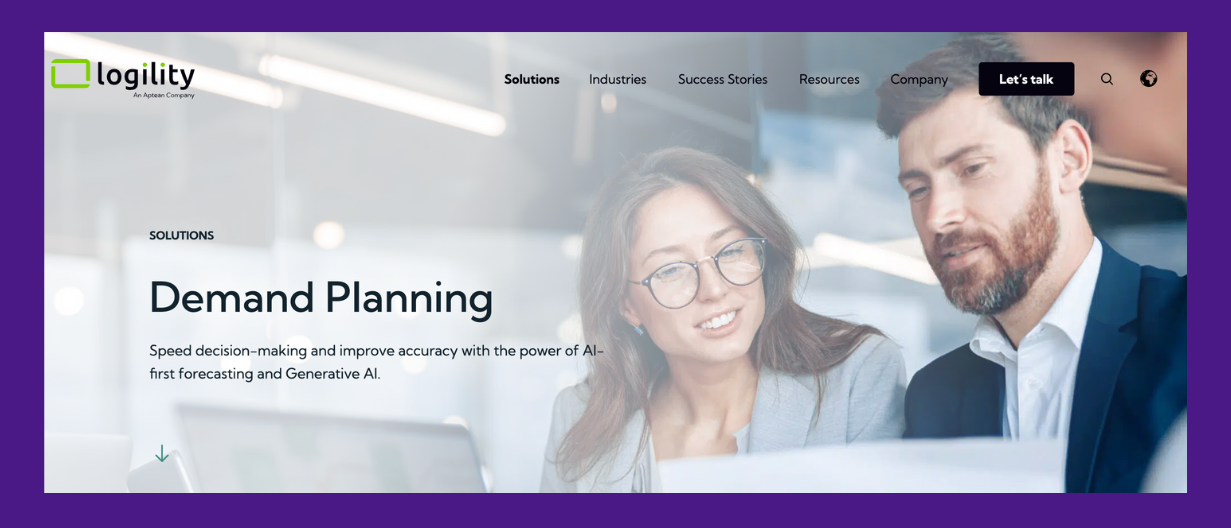
Logility is built for large-scale demand planning across global supply chains. It combines time-series forecasting, causal modeling, and generative AI to help teams adjust projections quickly based on market conditions, supplier constraints, or promotional events. It also includes tools to simulate the impact of demand shifts on inventory, production, and revenue.
This AI-powered demand planning software works best for brands managing complex SKUs across multiple markets. It’s not built for smaller teams that need quick setup or just basic forecasting, but for companies that need collaboration across planning, procurement, and distribution.
Key Features
- Uses AI to produce demand scenarios and planning narratives
- Includes causal models that factor in events like price changes and promotions
- Supports forecast versioning to compare historical, adjusted, and AI-generated plans
- Visual dashboard to monitor deviations between forecast and actual sales
- Integrates with broader supply chain planning modules like inventory and manufacturing
Pricing
Logility does not list its pricing on the website. You need to contact sales.
7. Cin7
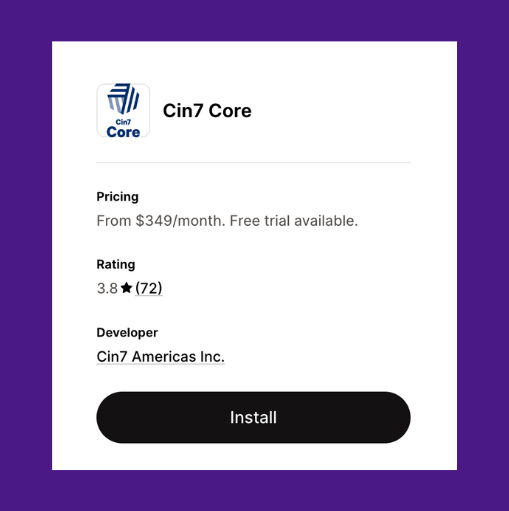
Cin7 helps businesses forecast demand while managing inventory across multiple channels. It pulls real-time data from suppliers, warehouses, and sales to generate forecasts using its ForesightAI engine. The system highlights stockout risks, overstocked SKUs, and fast-moving items so teams can take action before it affects revenue.
It works well for omnichannel sellers but not suited for teams looking for only a standalone demand planning layer. Since it’s built as a connected inventory platform first, the forecasting features come bundled into broader workflows.
Key Features
- ForesightAI flags high-risk and underperforming SKUs based on recent activity
- Forecasting is directly connected to purchasing, order routing, and inventory management
- Automation rules eliminate manual reordering and inventory tracking
- Dashboard centralizes data across the warehouse, sales, and supplier systems
- 700+ built-in integrations, including Shopify, Amazon, Xero
Pricing
Starts at $349/month for up to 5 users.
8. Infor

Infor delivers ML-driven demand projections using near real-time internal and external data. It automatically updates forecasts, senses shifts, and highlights exceptions so planners only need to intervene when anomalies occur.
It works well for industries with high SKU complexity and rapidly changing conditions. But since it’s embedded within Infor’s ecosystem, brands not using Infor ERP platforms may require additional configuration steps.
Key Features
- Uses demand sensing and ML to auto-update forecasts with real-time signals
- Supports exception-based planning so users focus only on data deviations
- Offers forecast versioning and compares historical, adjusted, and AI-generated plans
- Integrates deeply with Infor M3 CloudSuite for live data exchange and faster deployment
- Includes time-series models like Prophet and Croston for erratic or seasonal demand
Pricing
Custom quote based on your unique needs.
9. Leafio
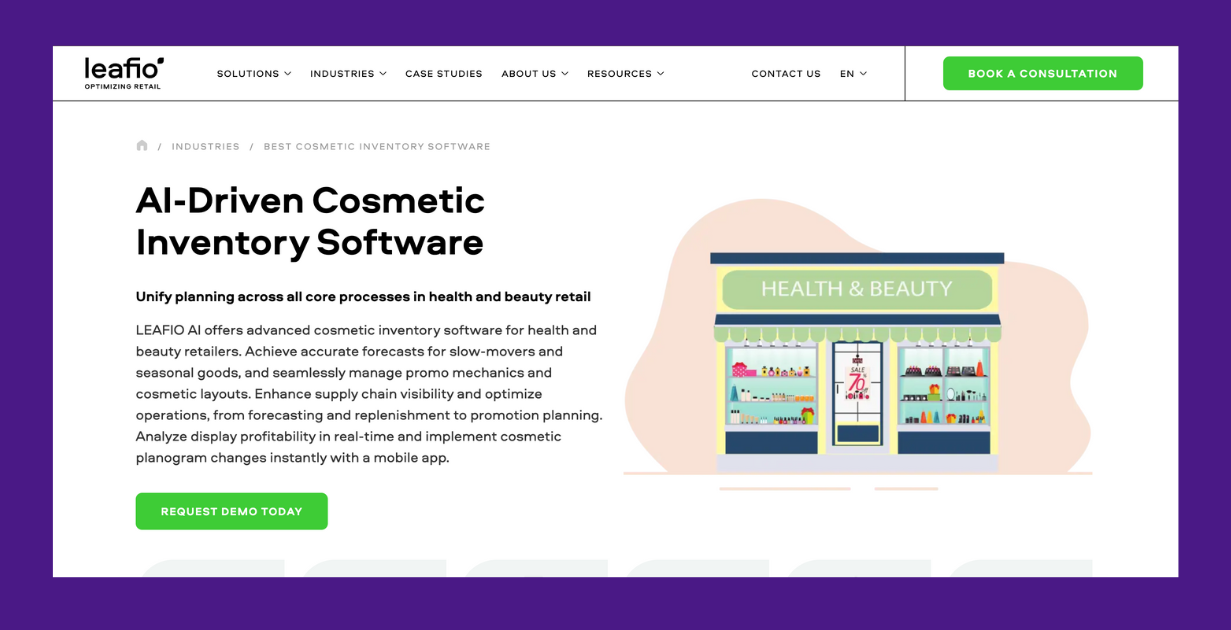
Leafio focuses on inventory and demand forecasting for multi-location retailers. It uses AI to automate core planning tasks like demand prediction, order generation, and replenishment.
The tool works well for teams looking to move away from spreadsheet-based planning. You can track inventory flow by location, monitor KPIs like turnover and shrink, and build demand models that self-correct over time.
However, it’s built for high-SKU environments and may be overkill for single-store operations that don’t need store-level granularity.
Key Features
- Forecasts demand at SKU‑store level using demand sensing and seasonality modeling (short‑, medium‑, long‑term)
- Multi‑scenario seasonality simulation based on market and promotional inputs
- Generation of orders and replenishment workflows tied to forecasts
- AI‑driven planogram automation that adjusts facings based on forecasted demand
- Centralized dashboard combining demand predictions, inventory status, and ordering action
Pricing
Custom quote based on your unique needs.
Learn how AI and automation in optimizing retail operations is reshaping how brands plan, replenish, and grow.
Use Right AI-Powered Demand Forecasting Software For Accurate Planning
AI demand forecasting isn’t about replacing your planning process, it’s about making it sharper.
The right tool can give you visibility into future demand, help you reorder at the right time, and reduce the impact of uncertainty, whether that’s seasonality, promotions, or shifting sales patterns.
Each tool we covered brings something different to the table. Some focus on automation, some on supply chain visibility, and some on ease of use for lean teams.
If you're looking for something built for growing Shopify brands, Prediko gives you granular forecasting including finished goods and raw materials, precise reordering, purchase order management and, advanced inventory reporting in one clean interface.
Start your 14-day free trial and see how Prediko handles demand shifts without the chaos.
.svg)





.png)

